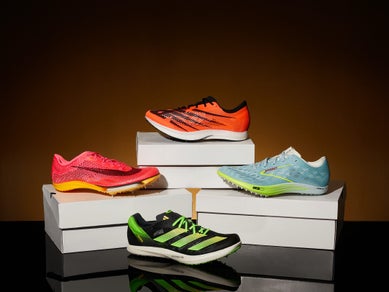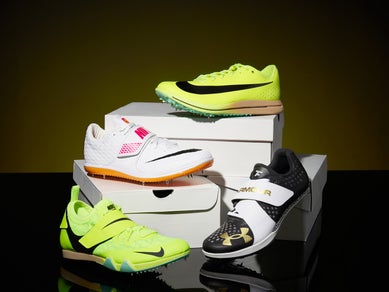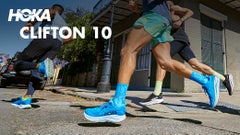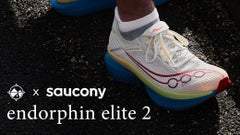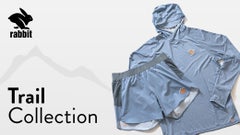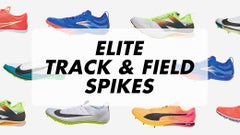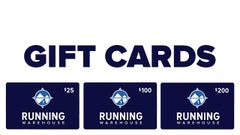The Best Sprint & Hurdle Spikes of 2025
Updated: December 9, 2024 by Loucas Kobold

While we love the thrill and competitive drama of all track and field events, none surpass the attention, excitement, and star power that comes with sprinting and hurdle events. To us and the world, there’s something undeniably special and captivating about watching the fastest athletes on Earth go head-to-head to see just how fast humans are. When every millisecond matters, it’s no wonder why sprint events are so popular. A vital key to unlocking that type of power and speed is having the best pair of spikes on your feet, which is why we're here to help guide you on your selection.
What Makes Spikes Best for Sprinting?
Sprint spikes are best suited for sprint and hurdle events like the 60m, 100m, 200m, and 400m, as well as the 100m/110m hurdles and 300m/400m hurdles, and of course, the showstopping 4 x 100m and 4 x 400m relays.
These spikes characteristically have a contoured and snug fit in order to be a secure and powerful extension of the foot. Sprint spikes will be very stiff and engineered to get athletes on their toes as quickly as possible, usually by a curved and powerful carbon fiber or TPU plate. The cushioning can range from nonexistent throughout (for traditional-style spikes) to thickly cushioned under the forefoot only (for new super spikes). In contrast, mid and long distance spikes typically feature rearfoot/heel cushioning, while virtually all sprint spikes appear to have minimal to no foam under the heel.
Since acceleration and speed are everything, the upper design of sprint spikes is as minimal and lightweight as possible while still being strong enough to harness and transfer all of your athletic power. Therefore, sprint spikes often have a little more padding around the ankle and generally speaking, are more structured and supportive compared to long distance spikes. However, some of the latest super spikes are blurring the lines between mid distance and sprinting, with some models proving capable across a broader range of distances.
Whether you're just starting or have years of sprinting under your belt, we know firsthand that picking the right shoe for your event is vital to getting an edge on race day, which is why we've applied our expertise and compiled this list of our top track and field sprint and hurdle spikes of the year. Not sure where to start? Read our guide on how to choose a track and field spike, and don't hesitate to reach out to us by live chat, phone, or email - we're here to help!
For a detailed explanation of how we test shoes and why you should trust our recommendations, read about our running shoe testing methodology.
Our Top Picks for the Best Sprint Spikes of 2025
- Best Sprint Spikes for Shorter Sprints adidas adizero Prime SP 3 Strung
- Best Sprint Spikes for Longer Sprints New Balance FuelCell SuperComp MD-X v3
- Best Sprint Spikes for Beginners and High School Athletes Nike Zoom Rival Sprint
Best Sprint Spikes for Shorter Sprints
adidas adizero Prime SP 3 Strung

With the 2024 world's fastest man headlining the roster of the world's greatest athletes, you know we HAD to recognize adidas; they're obviously doing something very right! With this adizero Prime SP 3 Strung, we've been gifted with a thick stack of uber-responsive Lightstrike Pro under the forefoot. Combined with a full-length glass fiber-infused plate and stunning Strung upper, this beast is just begging to explode off the blocks and bound through the tape. Some might call this pick a "surprise" victory over the fully worthy Nike Zoom Maxfly 2, but not us!
| At a glance: adidas adizero Prime SP 3 Strung |
|
Best Sprint Spikes for Longer Sprints
New Balance FuelCell SuperComp MD-X v3

Hold it right there! Are we even allowed to pick a MID distance spike here? Well, we did it, so hear us out. The New Balance FuelCell SuperComp MD-X v3 is a ridiculously worthy and championship-decorated option for the top pick in this category. This super spike has premium features like 100% PEBA superfoam and a full-length carbon fiber plate for world-class speed. While its stunningly broad range technically spans from 800m up to 5000m distances, we should recall these spikes were on the feet of gold winners in Paris for the 400m hurdles and the 200m, among other accolades. Maybe that only works for elites, but it's also worth trying for all of us. Yes, please!
| At a glance: New Balance FuelCell SuperComp MD-X v3 |
|
Best Sprint Spikes for Beginners and High School Athletes
Nike Zoom Rival Sprint

If you don't want to break the bank or for sprinters who run multiple events, we present the Nike Zoom Rival Sprint as the perfect choice. This spike can handle the power of the 60-meter, the finesse of relays, and the speed of the 400-meter. Plus, for athletes starting younger, it's also available in the Nike Zoom Rival Sprint Kids.
Note: For beginner hurdlers, we recommend the Nike Rival Multi Spike due to its added heel protection. This spike offers the same propulsive Pebax spike plate while providing increased levels of cushioning for those who are still developing the ideal form.
| At a glance: Nike Zoom Rival Sprint |
|
FAQ
1. What’s the difference between sprint, mid-distance, and long-distance track spikes?
Sprint spikes typically don't feature heel cushioning, and they tend to be stiffer, sturdier, and slightly heavier to handle peak forces. Some "classic" or "traditional" style sprint spikes might appear not to have any cushioning at all except a thin interior sockliner. Conversely, long distance spikes feature the tallest amounts of full-length cushioning and they're built to be the absolute lightest weight possible. Meeting in the middle, mid distance spikes blend these features to blur the lines between sprint spikes and long distance spikes. Mid distance spikes generally are a bit more aggressive than their long distance counterparts. Compared to long distance spikes, mid distance options often have more pins in the forefoot, longer or stiffer plates or shanks, slightly less cushioning under the rearfoot, and might be just slightly heavier and sturdier.
2. How do I choose the right track spikes for sprinting?
When it comes to selecting the right track spike, as with all running footwear, the most important factor to consider is what fits and feels best to you. Review the information above on the spikes featured on our list and consider how well they suit your needs, intended purposes, and events. Discuss it with your coach, and feel free to contact our customer service team by live chat, email, or phone - we're happy to help!
3. What are the top features to look for in a sprint track spike?
If you're looking for a top-notch super spike, one of the features it will most certainly have is one of the latest superfoams (usually PEBA/Pebax, TPEE, or A-TPU), likely paired with a full-length plate made out of high-performance thermoplastic (like Pebax), fiberglass, or (most likely) carbon fiber. And, of course, if all else is equal, lighter is better. Having said that, the lightest weight choice might not be best for you, so ensure it provides the right fit, feel, support, and experience for your preferences.
4. How do I know if my track spikes fit correctly?
We know the fit of spikes can be tricky, for sure. Unlike regular running shoes, spikes aren't built for comfort but for performance. Compared to shoes, spikes will automatically fit narrower and snugger, with less structured or supportive uppers, all for racing performance. For shoes, we recommend having a thumbnail's width of space in front of your longest toe. For spikes, it's normal for your toes to be closer to the front of the shoes, but there should still be a small amount of space to prevent cramping. For the most part, start by trying your spikes in the standard size you usually wear for training shoes. The spikes will feel smaller than you're used to, but make sure they feel secure (not too loose, no heel slipping) without being excessively tight (still a touch of room for toe comfort). Think about how long you'll have to wear your spikes (for your event and some warm-up time beforehand) and remember you can do part of your warm-up in shoes before switching to your spikes.
5. How often should I replace my track spikes for sprinting or short distance running?
For spikes with replaceable pins (the vast majority) instead of permanent pins, it's not uncommon to lose at least 1 or 2 pins at almost every track meet. For spikes in general (the entire shoe, including the upper, foam, plate, and outsole), depending on frequency and number of races and meets, they'll often be entirely used up and broken down after one school season.
6. Are there differences in spikes for synthetic tracks vs. natural (grass, dirt) tracks? What about pavement?
As a general rule of thumb, the fancier top-end spikes are best on synthetic rubber tracks. The majority of entry-level or simpler spikes can fare slightly better on dirt and grass from a personal comfort and spike durability perspective. Look closely at and feel the outsole material along the entire length of your spike - would you want that outsole on slippery grass or hard-packed dirt that might have rocks to step on? For some outsoles, the answer might be yes, while others will be no. If you're racing on a hard paved track, we'd recommend spikeless/flat/waffle options or a performance road shoe, if allowed. Try not to walk across pavement or hard surfaces with your spikes on, especially if the sharp pins are inserted - that's what a carrying bag (included in the shoe box for many models) is for.
7. Can I use the same spikes for multiple sprinting events of different distances?
While some spikes are intended more for the 60m-100m end of the range and others for the 400m, most sprint spikes have enough range versatility to race multiple distances. That said, using the same spikes for multiple events depends on your comfort level. In other words, if you're racing a full 400m lap, would you feel too much heel impact in a non-cushioned model? Or, if you're focused on 60m-100m, would a more cushioned model still feel connected, responsive, and stable enough for exploding off the blocks? You'll have a better sense of those answers based on your preferences.
8. What are the most popular brands for track sprint spikes?
Some of the most popular spike brands are undoubtedly Nike, with hot competition from adidas, PUMA, New Balance, Saucony, ASICS, and Under Armour.
9. How do I care for my track spikes to maximize their lifespan? Do I need to take the pins out after each track meet?
For greater longevity, try to use your spikes only on soft track surfaces and when you have to for racing and some practice. Keep your track spikes (and carry them) in a separate bag when not in use, and gently wipe away dirt, grit, and moisture after use before putting them away. Be sure to properly unlace your shoes instead of smashing your feet in them repeatedly or pulling them off while still tied. Lastly, you don't need to take the pins out each time after a meet, but you'll likely want to tighten some of them back up with the included spike tool. Snug them up flush, and don't overtighten them or get them cross-threaded when inserting the first time.
10. Are track spikes allowed in all running events and meets?
Track spikes are only for use on the track, and your coach will know best about what is and isn't allowed at each of your meet locations. If spikes are permitted, the "standard" pins are usually pyramid-shaped and 1/4-inch length or shorter. Many facilities discourage longer lengths and other shapes (such as needles), but virtually all track spikes come with standard pyramid spikes in the box.

